- Home
- About
- Map
- Trips
- Bringing Boat West
- Migration West
- Solo Motorcycle Ride
- Final Family XC Trip
- Colorado Rockies
- Graduates' XC Trip
- Yosemite & Nevada
- Colorado & Utah
- Best of Utah
- Southern Loop
- Pacific Northwest
- Northern Loop
- Los Angeles to NYC
- East Coast Trips
- Martha's Vineyard
- 1 Week in Quebec
- Southeast Coast
- NH Backpacking
- Martha's Vineyard
- Canadian Maritimes
- Ocracoke Island
- Edisto Island
- First Landing '02
- Hunting Island '02
- Stowe in Winter
- Hunting Island '01
- Lake Placid
- Chesapeake
- Provincetown
- Hunting Island '00
- Acadia in Winter
- Boston Suburbs
- Niagara Falls
- First Landing '99
- Cape Hatteras
- West Coast Trips
- Burning Man
- Utah Off-Roading
- Maui
- Mojave 4WD Course
- Colorado River Rafting
- Bishop & Death Valley
- Kauai
- Yosemite Fall
- Utah Off-Road
- Lost Coast
- Yosemite Valley
- Arizona and New Mexico
- Pescadero & Capitola
- Bishop & Death Valley
- San Diego, Anza Borrego, Joshua Tree
- Carmel
- Death Valley in Fall
- Yosemite in the Fall
- Pacific Northwest
- Utah Off-Roading
- Southern CA Deserts
- Yosemite & Covid
- Lake Powell Covid
- Eastern Sierra & Covid
- Bishop & Death Valley
- Central & SE Oregon
- Mojave Road
- Eastern Sierra
- Trinity Alps
- Tuolumne Meadows
- Lake Powell Boating
- Eastern Sierra
- Yosemite Winter
- Hawaii
- 4WD Eastern Sierra
- 4WD Death Valley +
- Southern CA Deserts
- Christmas in Tahoe
- Yosemite & Pinnacles
- Totality
- Yosemite & Sierra
- Yosemite Christmas
- Yosemite, San Diego
- Yosemite & North CA
- Seattle to Sierra
- Southwest Deserts
- Yosemite & Sierra
- Pacific Northwest
- Yosemite & South CA
- Pacific Northwest
- Northern California
- Southern Alaska
- Vancouver Island
- International Trips
- Index
- Tips
- Books
- Photos/Videos
- Search
- Contact
Morro Bay State Park and San Luis Obispo, CA
Tuesday, December 3, 2013 - 12:00pm by Lolo
32 miles and 0.75 hours from our last stop - 1 night stay
Travelogue
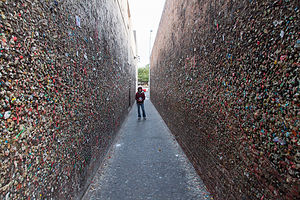 Lolo in Bubblegum AlleyThe weather had already begun to turn when we were up at Hearst Castle, but by the time we reached Morro Rock temperatures had dropped significantly and the winds were picking up, so much so that we couldn’t get out of the car to photograph the Rock without being pelted by sand—not exactly very conducive conditions for our plans of kayaking in Morro Bay.
Lolo in Bubblegum AlleyThe weather had already begun to turn when we were up at Hearst Castle, but by the time we reached Morro Rock temperatures had dropped significantly and the winds were picking up, so much so that we couldn’t get out of the car to photograph the Rock without being pelted by sand—not exactly very conducive conditions for our plans of kayaking in Morro Bay.
Part of our motivation for driving south along the coast was to get a chance to use our much neglected kayaks. The two places we had picked to use them were Morro Bay and the La Jolla Sea Caves. Needless to say, the weather was definitely not going to allow us to kayak in Morro Bay, and unfortunately, the forecast didn’t look to promising for La Jolla in a few days either. How ironic that we were able to kayak in the Russian River in Northern California last week, and were now being thwarted in Southern California. This was all feeding into Andrew and Tommy’s plan for us to eventually move to Northern California rather than Southern, where my sun-worshipping husband hoped to find a warmer climate.
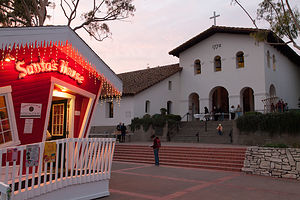 Santas House at Mission San Luis ObispoSo, instead we had to content ourselves with admiring the Rock through our sand-covered car window. It really was a very impressive rock, or more correctly a volcanic plug, known as a “morro.” In fact, there are nine morros called the Nine Sisters that form a chain between Morro Bay and San Luis Obispo. This one is the most well known and photographed though, because it stands in the entrance to the harbor, while the rest are on land. You can drive right up to this 576-foot beast over a short causeway, but you’re not allowed to climb on it because it is home to endangered peregrine falcons.
Santas House at Mission San Luis ObispoSo, instead we had to content ourselves with admiring the Rock through our sand-covered car window. It really was a very impressive rock, or more correctly a volcanic plug, known as a “morro.” In fact, there are nine morros called the Nine Sisters that form a chain between Morro Bay and San Luis Obispo. This one is the most well known and photographed though, because it stands in the entrance to the harbor, while the rest are on land. You can drive right up to this 576-foot beast over a short causeway, but you’re not allowed to climb on it because it is home to endangered peregrine falcons.
Hoping to have a better shot at it the next day, we drove into Morro Bay State Park, right near the bay, where we planned to camp for the night. When we told the ranger at the entrance booth that we had just been to Hearst Castle, he told us that the State Park employees were having their holiday party there that night. I was so envious. I mean the tour was great, but I am sure nothing compared to having the run of the place. I wonder if they get to swim in the Roman pool.
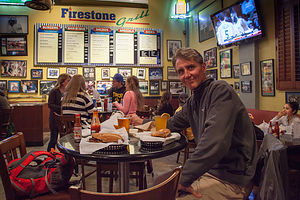 58 Year Old Herb at Firestone GrillOne of my major reasons for stopping here, other than the hope of kayaking, was to see the nearby town of San Luis Obispo, which we had heard so many good things about. Herb and I will eventually move to the West Coast and we are always on the lookout for possible places to live. A college town is pretty much a must for us, for the culture and liveliness, so Cal Poly put this one in the running.
58 Year Old Herb at Firestone GrillOne of my major reasons for stopping here, other than the hope of kayaking, was to see the nearby town of San Luis Obispo, which we had heard so many good things about. Herb and I will eventually move to the West Coast and we are always on the lookout for possible places to live. A college town is pretty much a must for us, for the culture and liveliness, so Cal Poly put this one in the running.
As we always do when exploring a new place, we consulted our guidebooks and came up with a few things we’d like to see – in this case, the Mission San Luis Obispo de Tolosa and Bubblegum Alley, which admittedly fell on opposite ends of the cultural and historical significance spectrum. Since our visit to Seattle’s Bubblegum Alley, I have changed my view of this form of public art from “Oh, gross,” to “Oh, look at how the various colors and the textures play off each other.”
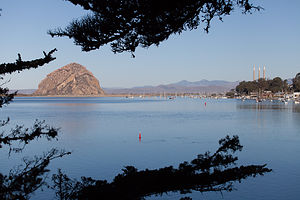 Morro Rock with SmokestacksWe thought finding the Alley might be tough, but ironically, after searching for parking, we finally found a spot on Higuera Street, literally right in front of it. There certainly was a lot of chewed gum on display in this 15 foot high, 70 foot long alley. I wonder how many cavities it is responsible for.
Morro Rock with SmokestacksWe thought finding the Alley might be tough, but ironically, after searching for parking, we finally found a spot on Higuera Street, literally right in front of it. There certainly was a lot of chewed gum on display in this 15 foot high, 70 foot long alley. I wonder how many cavities it is responsible for.
Our next stop was the Mission San Luis Obispo de Tolosa, one of the string of missions established in California by the Spanish back in the late 1800s. There was plenty of activity around Mission Plaza that night, as Christmas was coming and Santa had set shop in the Plaza. Herb wanted to move on and explore the rest of the town, but I kept stalling because I wanted to hear the mission bells on the hour, and it was just a few minutes shy of 7:00.
It was so festive in the Plaza, and I was finally beginning to get in the Christmas mood, which was hard for me being so far from home and in places that had palm trees rather than Douglas firs.
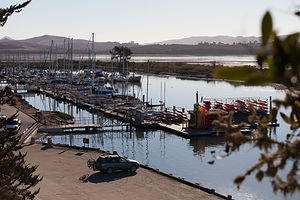 Moro Bay State Park MarinaAfter the bells, we strolled through town, taking note of the fact that it felt real and not just a tourist trap.
Moro Bay State Park MarinaAfter the bells, we strolled through town, taking note of the fact that it felt real and not just a tourist trap.
We went for dinner at the Firestone Grill for Herb’s birthday dinner, a place that had been highly recommended to us by the man who filled our propane tanks earlier in the day. The place was noisy and fun, and obviously a hangout for Cal Poly students. As per our propane man’s recommendation, we ordered the tri-tip steak sandwiches, and while we were waiting for them, I went to the bar to order us some Hefeweizen (Herb) and a Firestone IPA (me). I couldn’t believe it when the bar bill was only $5. No wonder the Cal Poly students hang out here. The tri-tip sandwich did not disappoint and we had a very fun evening.
The next morning, before continuing south, we tried once more to photograph Morro Rock. This time instead of driving out on the causeway to the base of it, we hiked the short trail from the marina up to the State Park’s Museum of Natural History on top of the hill. From here, depending on how you framed it, you could either get the pristine natural beauty of the rock rising from the waters of the bay, or swing a little to the right and include the unsightly smokestacks of the power plant rising from the shore – a very odd and incongruous partnership indeed.
Description
Morro Bay State Park
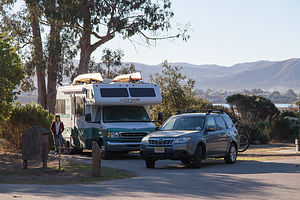 Moro Bay State Park CampgroundMorro Bay State Park is located on Morro Bay, 15 miles northwest of San Luis Obispo along scenic Highway 1. There is a 95-site campground in the park, 27 of which have partial hookups.
Moro Bay State Park CampgroundMorro Bay State Park is located on Morro Bay, 15 miles northwest of San Luis Obispo along scenic Highway 1. There is a 95-site campground in the park, 27 of which have partial hookups.
The most prominent feature in the area is Morro Rock, a 576 foot high volcanic plug that stands at the entrance to the harbor. This is one of nine “morros” or volcanic peaks that form a chain between Morro Bay and San Luis Obispo. There is a short causeway connecting the rock with the shore, but climbing on the rock itself is prohibited, because it is a reserved for the endangered peregrine falcon.
The calm waters of the bay are perfect for fishing, kayaking, and birdwatching. There are more than 15 miles of protected waters in the beautiful Morro Bay Estuary / Bird Sanctuary, which is home to California sea lions, harbor seals, sea otters, brown pelicans, and peregrine falcons.
The most popular hike in the park is to the 640-foot summit of Black Hill, one of the nine morros, from which there are spectacular views of Morro Bay and the nearby hills of Montana de Oro.
San Luis Obispo
San Luis Obispo is located at the junction of Highway 1 and US 101. Sometimes referred to as a “little Santa Barbara,” It is tucked into the mountains about halfway between Los Angeles and San Francisco.
Like many other towns and cities in California, San Luis Obispo was first established as a Spanish mission by Spanish Franciscan friars in 1772. Today the Mission San Luis Obispo de Tolosa is still an active church. The former friars’ quarters is now a small museum with artifacts from the Chumash Indians and the early Spanish settlers.
Today, the town’s main appeal is its charming, pedestrian-friendly downtown, with fine shops, galleries, and restaurants. Mission Plaza, with its brick paths and park benches along a creek, serves as the town square, often hosting festivals and concerts. During the school year the town bustles with students from California Polytechnic State University, more popularly known as Cal Poly.
- ‹ previous
- 6 of 13
- next ›
Morro Bay State Park and San Luis Obispo location map in "high definition"
Javascript is required to view this map.
